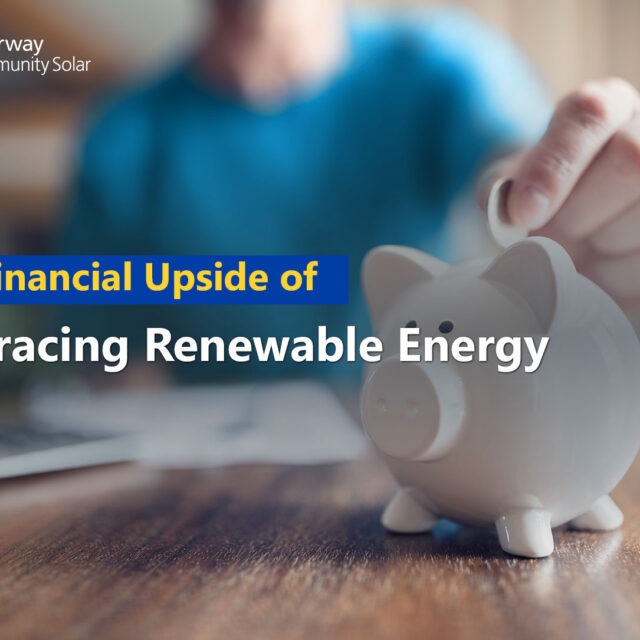
Our first place winner for the 2019 Essay Contest Scholarship is Reese O’Craven! Reese is a Sophomore at the University of Washington and is majoring in Community, Environment, and Planning. Reese’s winning essay, “Revolutionizing the American Energy Sector with Renewable Energy,” won the first place $5,000 prize. Read their winning essay!
Revolutionizing the American Energy Sector with Renewable Energy
Reese O’Craven
University of Washington
This planet is changing quickly – and it’s not a pretty picture. The average world temperature today is 0.6°C higher than it was 30 years ago and, with current policies, is on track to rise by at least at least 3°C by the end of the 21st century (IPCC 2018). Warming beyond 2°C is projected to result in rising sea levels, ocean acidification, increased rates of natural disasters, decreased agricultural productivity, and massive biodiversity loss. Rising temperatures are associated with a rapid increase in the concentration of CO2 in the atmosphere, which (alongside other greenhouse gases) interferes with the ability of infrared radiation to escape the atmosphere and results in increased global temperatures (Sachs 2015, 399-407). Switching from fuel-based power generation to renewable energy is a key strategy in any meaningful effort to reduce emissions and combat climate change.
The advantages of renewable energy are both numerous and significant: inputs (such as wind, sunlight, and water) are often cost-free and inexhaustible, and outputs are carbon free and do not contribute to rising global temperatures. Investing in the construction of renewable energy production creates jobs, increases demand for skilled labor, and incentivizes technological and innovative breakthroughs. But despite these benefits, the United States sources just 11% of its energy from renewable sources, over half of which is biomass, a less-efficient and higher cost source of renewable energy (EIA 2017). The technology exists, the economics check out, and the positive social externalities are apparent: so why do fossil fuels continue to dominate the power generation market in the United States?
Much of it has to do with inertia: fossil fuels have been used to generate energy since the mid 19th century, while modern renewables (i.e wind turbines and solar panels) did not emerge until the mid 1980s (BP 2019). Many American power plants are not yet at the end of their useful lives, and renewable energy generation at scale has remained cost-prohibitive until the last decade. Recent developments in the technology of photovoltaic (PV) solar panels have increased their efficiency and reduced their cost to the point where PV panels are are, in many cases, cheaper than conventional electricity generation on a per-watt basis. The Energy Information Administration’s Annual Energy Outlook paper for 2019 shows that photovoltaic solar has the highest capacity-weighted average value-cost ratio of all power generation sources in the US, with even higher value in regions of the U.S. that boast high solar potential (EIA 2019).
Renewable energy is not without drawbacks: the efficiency of technologies such as wind turbines and solar panels is vastly dependent on geography, and as a result, the viability of adoption of renewables is not uniform across the United States. In addition, most renewable energy techniques are inherently variable in the amount of electricity they produce as a direct consequence of having non-fixed inputs (i.e. wind turbines can only operate when there is wind, while coal plants can generally operate regardless of weather). But although these factors pose a barrier to an immediate transition to 100% renewable energy, they do not preclude a significant and prompt increase in the share of energy generated using sustainable methods. Society does not lack the means to adopt widespread renewable energy: the technology exists, and it is scalable. But whose job is it to make it happen?
This question is key: in order to catalyze change, action must be taken by someone – or, more accurately, many people. Strategies for increasing the share of renewables in the energy sector thus must have the effect of encouraging individuals and groups to take initiative. This essay outlines four primary strategies that reduce barriers and/or promote action in government, corporate, and individual domains.
The first step towards increasing the share of renewable energy in the power generation sector involves encouraging private investment through tax credits and direct funding. Financial incentives and subsidies have historically had a huge impact on renewable energy adoption: for example, the Obama-era Section 1603 program spent $26B USD (0.0007% of the annual federal budget) to provide partial funding for over 100,000 clean energy projects between 2009 and 2018. Government funds provided approximately 30% of the capital invested in these projects, with the remainder being sourced from private investors. Projects funded by this program provide 2.3% of electricity in the US today – enough to power more than 8 million homes (U.S. Department of the Treasury 2018). Replacing this program with a similar – or more ambitious – incentive-based program would encourage investment in renewable energy projects, which are already economically viable with current technologies. Increased funding might be accompanied by divestment from government subsidies in non-renewable energy generation, which presently account for between 48 and 58% of government expenditure on energy subsidies (EIA 2018).
Financial barriers are not the only hurdle renewables projects face: prospective solar and wind farms often must navigate complicated zoning and land use laws in order to begin projects. These barriers vary greatly based on state, project type, and community, and exist for good reason: the use of land is incredibly important to local communities, biodiversity, and potential negative externalities related with energy generation projects. However, simplifying and streamlining processes of applying for permits, holding community consultations, etc. though standardized procedures and increased public-private cooperation would also help to encourage investment in green energy projects.
Due to its scope, its budget, and its structure, governmental influence is likely the most powerful and far-reaching tool for promoting the adoption of renewables. But climate-skeptical perspectives embraced by the current presidential administration suggest that the federal government may not be ready to take decisive action in time to avoid the worst consequences of climate change. Social lobbies, activism, and social movements are important influencers of government and should be encouraged, but it is also worth looking beyond the government to identify alternate catalysts of meaningful change.
Research universities in the US command a tremendous amount of influence in both social and scientific spheres. Although public universities are not entirely independent from the government, they generally have a high degree of freedom regarding the research and educational programs they fund. Universities should increase their investment in a) research into increasing the efficiency of renewable energy generation, b) educational programs that prepare individuals for careers in renewable energy, c) general education regarding the need for immediate action in order to avoid the worst impacts of climate change, and d) environmental and social leadership in the form of investing in clean energy generation for their campuses and projects. Research has the opportunity to spawn new electricity generation strategies and to improve energy-efficiency of existing technologies, both of which will increase the viability of private investment in renewable energy. Increasing the awareness of the importance of sustainability through general education will help to inspire a new generation of youth to take action and make a concerted effort to have a positive impact on their world. The impact of education should not be limited to higher education: by increasing climate awareness at every level of education, more and more youth will be inspired to invest in renewable energy and explore future careers related to the industry.
A final step – and perhaps the most important one – involves empowering individuals to personally contribute to increased adoption of renewable energy. The American population is becoming increasingly concerned with climate change, but many of those who want to make a difference don’t know how to help. Public and private enterprises that allow consumers to opt into carbon-neutral goods or services are a powerful tool for involving individual citizens in the renewable energy generation process. This strategy can be implemented in a variety of ways: utilities investing in “green energy” offsets for an increased price, community solar projects that offer the benefits of rooftop solar at a higher rate of efficiency due to economies of scale, selling carbon offset credits with high-carbon purchases such as airplane flights, etc. There are more than 330 million people living in the United States: giving them the means to personally contribute to a better, more livable world presents an opportunity to reshape a national culture while accelerating the adoption of sustainable infrastructure in this country.
The United States is on the brink of an energy revolution – but in order to transform its energy sector from fossil-fuel dependence to clean power generation, this country will need participation from public, private, and social stakeholders. No single change will be enough to revolutionize the American energy sector on its own; steps outlined in this document are just a few of many strategies that must be employed in combination to address a challenge of immense scale. In order to increase the contribution of renewable energy sources, the federal government should take decisive action to provide incentivize investment in renewable energy research, innovation, and infrastructure. But should the government fail to show initiative in changing the way this nation powers its cities, the torch must pass to individuals, educational institutes, and private companies, all of whom have the power to invest in energy projects that will help lead America into a brighter future.
References
- British Petroleum. 2019. “BP Statistical Review of World Energy”. https://www.bp.com/content/dam/bp/business-sites/en/global/corporate/pdfs/energy-economics/statistical-review/bp-stats-review-2019-full-report.pdf
- EIA. 2018. “U.S. primary energy consumption by energy source, 2018”. https://www.eia.gov/energyexplained/us-energy-facts/
- EIA. 2018. “Direct Federal Financial Interventions and Subsidies in Energy in Fiscal Year 2016”. https://www.eia.gov/analysis/requests/subsidy/pdf/subsidy.pdf
- EIA. 2019. “Levelized Cost and Levelized Avoided Cost of New Generation Resources in the Annual Energy Outlook 2019”. https://www.eia.gov/outlooks/aeo/pdf/electricity_generation.pdf
- Intergovernmental Panel on Climate Change (IPCC). 2018. “Radiative Forcing of Climate Change”. Accessed October 16th, 2019. https://www.ipcc.ch/site/assets/uploads/2018/03/TAR-06.pdf
- Sachs, Jeffrey. 2015. The Age of Sustainable Development. New York, NY: Columbia University Press.
- U.S. Department of the Treasury. 2018. “Final Overview of the §1603 Program”. https://www.treasury.gov/initiatives/recovery/Documents/P%20Status%20overview%202018-03-01.pdf









